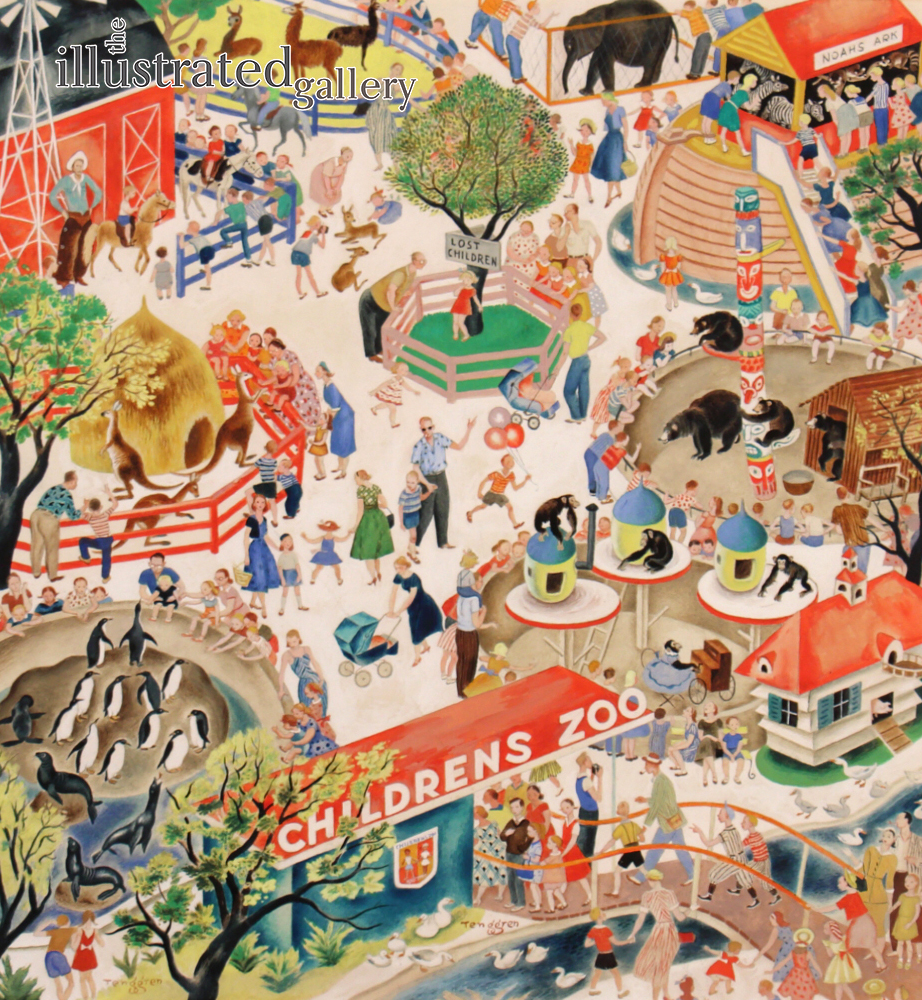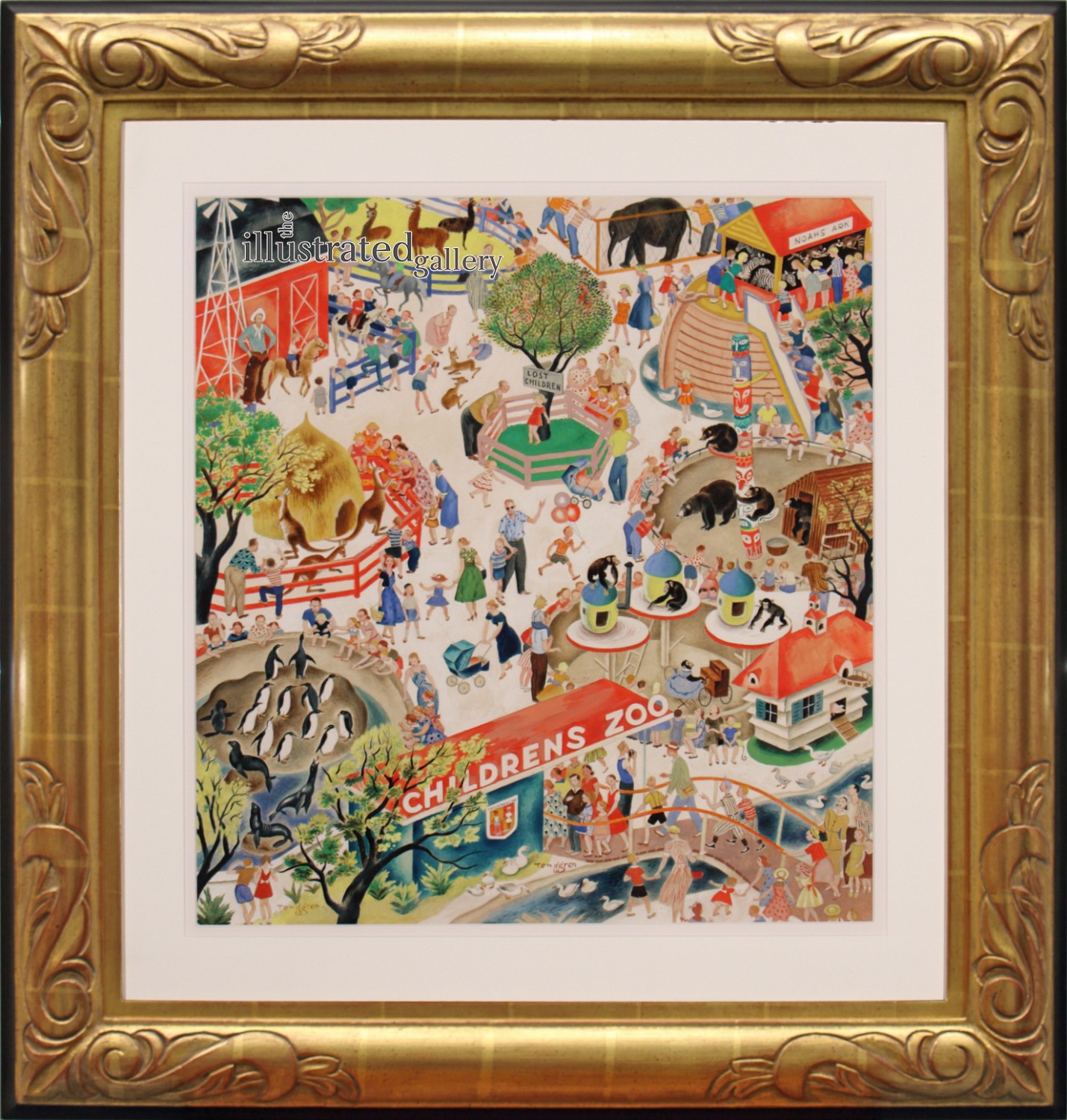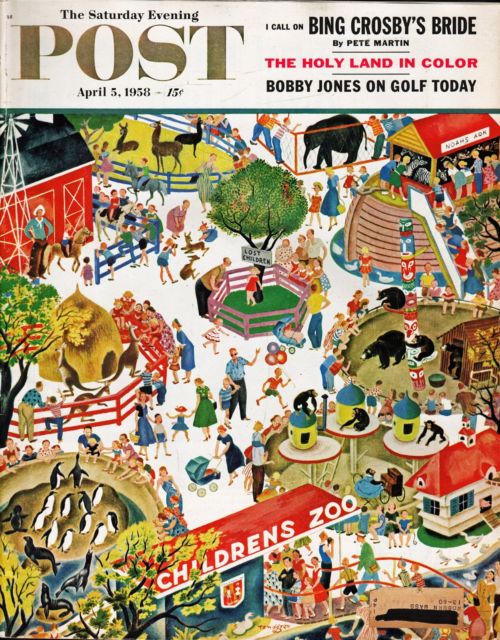"Zoo Scene, Saturday Evening Post Cover" Lot no. 3344
By Gustaf Tenggren (1896 - 1970)
1958
17.00" x 16.00", Framed 27.00" x 25.50"
Gouache
Signed Twice in Lower Portion
REQUEST PRICE
PURCHASE REQUEST
Original cover illustration for The Saturday Evening Post, April 5 1958. The Post described, “Do you mind if each character on the cover isn't discussed individually this time? Artist Gustaf Tenggren, evoking the magic of artistic license, has taken some details from the Brookfield children’s zoo, Chicago, and some of the famous wild-critter collection in Philadelphia, thus enabling those youngsters to go to two zoos at the same time. Example: the chimpanzee village, lower right, is in Chicago, but Miss Chimp is cranking her hand organ in Philly. And if that little girl, center, got lost over on Philadelphia's Noah’s Ark, she must be really confused by now because the place they have parked her is in the other zoo. In real life a moat encircles that bear pit, but in the better world of an artist’s fancy, bears and children get along fine together.”
Explore related art collections: Saturday Evening Post Covers / Animals / Magazine Covers / $50,000 - $100,000
See all original artwork by Gustaf Tenggren
ABOUT THE ARTIST
Gustaf Tenggren was born on November 3, 1896 in the parish of Magra in Vastergotland, western Sweden. His parents Aron and Augusta had totally seven children and Gustaf was the second youngest of them. Gustaf 's father, Aron, was a painter and decorator, just like his father in turn, Johan Teng. In 1898, the Tenggren family took south for Gothenburg, as the outcome on the countryside had turned too insufficient. A one room flat in Garsa, gothenburg, became their new home were, the year after their arrival, Gustaf's younger brother Gunnar was born. Shortly after their arrival, Gustaf's father left the family to try tio find work in the U.S.A., and the children were to grow up without their father. Still after the move to Gothenburg, Gustaf spent his first two years at school in Magra, where he also spent the summer holidays. These years, dwelling closely to his grandfather, had a great influence on his choice of occupation later on.
From eleven years of age, Gustaf had to contribute to the family income by working as a runner boy and as an apprentice by a lithographer's shop. But soon his artistic talent was observed, and he was encouraged to attend an art school. A scholarship 1910 helped him to begin the school for arts and crafts in Gothenburg, Slöjdföreningens skola, at only 13 years old while still keeping his day-time job. By autumn 1914 he received a new scholarship and attended Valands Konstskola. While still at school he got his first illustration commissions, and parallell to that he painted decorations for the town theatre, Stora Teatern, and executed portrait commssions.
After John Bauer’s final job of illustrating Bland Tomtar och Troll in 1915, president and owner of publishing company Åhlen och Åkerlund’s, Erik Åkerlund, was in desperate need of a successor to the job. Gustaf Tenggren had a try in 1917, got the job in 1918 and was to keep illustrating the album for eight more years, totaling 10 volumes, where Bauer only had made eight. The same year he married his first wife, Anna Peterson, the sister of his best friend Rudolf Peterson, who later became the father of Sweden's most loved comic characters, 91:an Karlsson.
In summer of 1920 Gustaf and Anna decided to leave for the United States. They arrived in New York in August, and continued on to Cleveland, Ohio where Gustafs's two sisters had already settled. After two yars of hard work, they moved to New York, where Gustaf's career really took off. The twenties in New York City implied a tremendous progress for Gustaf Tenggren, both artistically and economically. In1930 he re-married to a girl of Swedish origin, Malin or Mollie Froberg, and in 1929 when the Great Depression hit the nation, they left New York for a more slow-paced life in the rural surroundings of Rhinebeck, Dutchess County in upstate New York. Here they spent five years as farmers, keeping a horse, a cow, a pig, a dog, and 40 hens, until they finally went back to New York City in 1935.
In 1935, Gustaf Accepted an offer to work as an Art Director at Snow White and the Seven Dwarfs which was currently under production at Walt Disney's Studios in Los Angeles. For almost three years he painted inspirational artwork to help the layout artists to find the right mood for the actual scenes and backgrounds. His paintings had a major influence on some central scenes, such as the interiors of the dwarfs’ cottage, the queen’s laboratory, and the scenes in the woods where Snow White flees from the hunter. He also contributed to Bambi, The Ugly Duckling, Hiawatha and Fantasia. But his greatest addition was to Pinocchio which at the largest part obliged to Gustaf Tenggren for the design of environment, clothing and props. After leaving the studio in 1939, parallell to other children's book illustration commissions, he started to develop book projects of his own, bearing his own trade mark, The Tenggren books.The first was The Tenggren Mother Goose and it was followed by a number of similar compilations of folk tales and traditional stories. At the same time, he began his engagement with The Golden Press, producing a series of million-selling mass market picture books, among them theWorld's most printed, The Poky Little Puppy
The later years of their lives, Mollie and Gustaf spent on theproperty they bought 1944 at Dogfish Head, Southport, Maine. A collection of Swedish antiques became a link to his motherland, which he never revisited. April 6th, 1970, he died from lung cancer at the local hospital in West Southport. Molle lived for 14 more years and died in 1984. By then she had taken the means of donating the collection of Gustaf's paintings and illustration to University of Minnesota, Minneapolis. Now it's integrated with the Kerlan Collection, one of the World's greatest Children's literature research centres.





